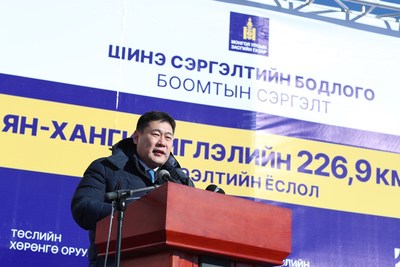ULAANBAATAR, Mongolia, Nov. 25, 2022 /PRNewswire/ — The Prime Minister of Mongolia, L. Oyun-Erdene, has today opened a major new rail link which will provide a significant boost to the country’s export competitiveness and wider economy as part of the Government’s ‘New Recovery Policy’.

The Zuunbayan-Khangi railway, which runs for 226.9km across south eastern Mongolia, provides a vital connection between the Tavantolgoi-Zuunbayan railway and the Khangi-Mandal border crossing on the Mongolia–China border.
Through a further connection to a new railway under construction on the Chinese border, the transportation distance for freight across this important economic corridor will be almost halved, significantly boosting trade in minerals such as iron ore.
With construction of the Zuunbayan-Khangi railway only beginning in March 2022, the completion of this project is set to lead to a rapid 30% increase in Mongolian export freight volume, with annual freight volumes set to stabilise at around twice their current level of 10.4 million tonnes from 2025, significantly boosting state budget revenues and local employment.
Speaking following the opening, the Prime Minister of Mongolia, L. Oyun-Erdene, said:
“The new Zuunbayan-Khangi railway was built in just eight months, through a public-private-partnership investment model, and is Mongolia’s new gateway for transporting mining export products competitively to the global marketplace.
” Today’s opening marks a major milestone in the Government of Mongolia’s ‘New Recovery Policy’, which is focused on strengthening the country’s economy following the pandemic and making Mongolia into a leading Asian country by 2050.”
Having no access to the sea, Mongolia relies on 42 dry-road border points for its trade, yet as of March this year only three of them were connected by railroads. The completion of this project delivers a second new railway crossing in the south of the country, and the ambition of the New Recovery Policy is to ensure that all border points are connected by roads, railways and highways in consecutive steps.
180 companies and over 3,500 workers took part in the construction of the railway.

SOURCE The Government of Mongolia



















